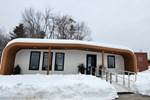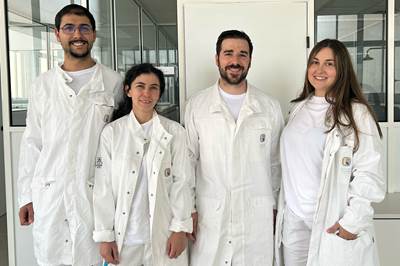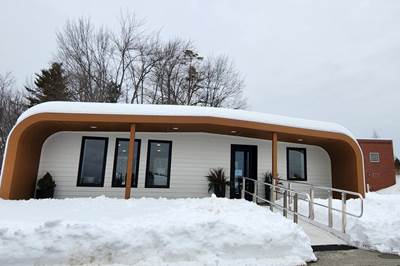California grant extends affordable, 3D-printed housing efforts by Mighty Buildings
Three prefabricated, low-carbon homes, using Mighty Buildings’ large-format 3D printing and UV-curable resins, will be built in the San Francisco Bay Area as models for future industry developments.
In CW’s 2020 article, Mighty Buildings explains that it has created a proprietary printing material and technology which allow the company to UV cure an extrudable gel that cures quickly enough to be able to support its own weight, unlocking the ability to print unsupported spans and organic shapes. The printing material is called Light Stone Material (LSM) and the 3D printing process is called Photo Activated Component Extrusion (PACE). Photo Credit: Mighty Buildings
Mighty Buildings (Oakland, Calif., U.S.), with partners led by Lawrence Berkeley National Laboratory (LBNL, Berkeley) have been awarded a $5 million GFO-22-305 grant from the California Energy Commission. The funding supports the partners’ work to develop, test and demonstrate zero-carbon or near-zero-carbon, cost-effective, modular and manufactured 3D-printed homes that can be readily deployed, particularly in under-resourced communities.
The companies intend to develop three advanced prefabricated low-carbon townhouses in Bay Point, California, in the San Francisco Bay Area, which will benefit low-income families (80% AMI or less) via partner Habitat for Humanity. Mighty Buildings will construct the homes’ walls using its 3D printing technology at its Oakland factory, and construction assembly is expected to be completed within a few days at the site location. The project’s research aims to drive long-term value in affordability, sustainability, resilience and speed of construction via new features that can positively transform the industry, including:
- A “cool room” concept: Using solar PV paired with a small battery, in tandem with a highly efficient envelope design and equipment, the homes will each feature a high-efficiency, mini-split heat pump system. The “cool rooms” will reduce peak loads by shifting to low-power operation during times of acute grid stress, and by shifting the peak load from a concentrated single-peak period in the evening to multiple scattered-peak periods throughout the day. The goal will be to provide greater resilience through events like power outages and extreme temperature events while generating more consistent billing cycles and a 10-year lower total cost of ownership (TCO);
- Advanced 3D printing manufacturing techniques: The project aims to introduce new methods of off-site 3D printing manufacturing, as well as a new energy-efficient panel, which are expected to have the highest level of off-site completion in the industry, according to the company;
- On-site structural/waterproofing test kits: Advanced testing equipment will be introduced to the manufacturing site, serving to accelerate innovation and certification cycle times;
- Energy and general manufacturing cost model: LBNL plans to develop a first-of-its-kind model based on Mighty Buildings manufacturing inputs that could be applied more broadly toward future projects using prefab, modular and panelized industry solutions;
- Training program: In collaboration with Mighty Buildings, Habitat for Humanity will create an in-person and digital training program to upskill labor and teach the basics of panelized prefab construction;
- Reduced 10-year TCO: The homes will target a 25% reduction in costs against a similarly sized home based on their zero-carbon and near zero-carbon footprints over a 10-year period, helping to pave a path for more affordable and resilient modular homeownership from underserved communities. The partners anticipate that these savings will grow to as much as 35% when scaled on larger projects.
“We are thrilled to embark on this groundbreaking project. Our collaboration with Lawrence Berkeley National Laboratory and Habitat for Humanity reflects our commitment to innovation, sustainability and our community,” Scott Gebicke, CEO of Mighty Buildings, says. “The support provided by this grant goes beyond building three townhomes; it’s actively shaping the future of construction in California. We envision a future where affordable, resilient and energy-efficient homes are the standard, not an exception.”
The homes are expected to be built much more quickly than traditional construction. For developers, the shorter build time and the associated interest savings are estimated to enable construction by as much as 20-30% more housing units. For home operations, the total utility savings is estimated to be as much as 40%, with even greater savings expected for larger multi-family units due to scale. The partners plan to continue to develop their strategy and addition of new partners through 2024 with production slated for later that year.
Related Content
Carbon fiber in pressure vessels for hydrogen
The emerging H2 economy drives tank development for aircraft, ships and gas transport.
Read MorePrice, performance, protection: EV battery enclosures, Part 1
Composite technologies are growing in use as suppliers continue efforts to meet more demanding requirements for EV battery enclosures.
Read MorePEEK vs. PEKK vs. PAEK and continuous compression molding
Suppliers of thermoplastics and carbon fiber chime in regarding PEEK vs. PEKK, and now PAEK, as well as in-situ consolidation — the supply chain for thermoplastic tape composites continues to evolve.
Read MoreLarge-format 3D printing enables toolless, rapid production for AUVs
Dive Technologies started by 3D printing prototypes of its composite autonomous underwater vehicles, but AM became the solution for customizable, toolless production.
Read MoreRead Next
Continuous fiber-reinforced, 3D printed houses on the horizon
3D-printed modular building manufacturer Mighty Buildings moves toward certification of higher-strength, more sustainable glass fiber-reinforced housing panels.
Read MoreKeyland Polymer opens UV-cured solid resin R&D lab in Spain
The new state-of-the-art facility in Barcelona is staffed to grow Keyland’s UV resin R&D, production and sales used in inks, AM, composite powder coatings and other products.
Read MoreUMaine BioHome3D meets sustainability, strength and durability goals
Data collected from one year of outdoor testing reasserts the 3D-printed, bio-based structure’s viability to address housing challenges, sets the stage for future development.
Read More
























